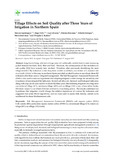Mostrar el registro sencillo del ítem
Tillage effects on soil quality after three years of irrigation in Northern Spain
| dc.creator | Apesteguía Barberena, Marcos | es_ES |
| dc.creator | Virto Quecedo, Íñigo | es_ES |
| dc.creator | Orcaray Echeverría, Luis | es_ES |
| dc.creator | Bescansa Miquel, Paloma | es_ES |
| dc.creator | Enrique Martín, Alberto | es_ES |
| dc.creator | Imaz Gurruchaga, María José | es_ES |
| dc.creator | Karlen, Douglas | es_ES |
| dc.date.accessioned | 2017-11-15T08:00:41Z | |
| dc.date.available | 2017-11-15T08:00:41Z | |
| dc.date.issued | 2017 | |
| dc.identifier.issn | 2071-1050 (Electronic) | |
| dc.identifier.uri | https://hdl.handle.net/2454/26132 | |
| dc.description.abstract | Irrigation is being initiated on large areas of traditionally rainfed land to meet increasing global demand for food, feed, fiber and fuel. However, the consequences of this transition on soil quality (SQ) have scarcely been studied. Therefore, after previously identifying the most tillage-sensitive SQ indicators under long-term rainfed conditions, conversion of a research site on a Haplic Calcisol in Navarre, in northeast Spain provided an ideal location to reevaluate those SQ indicators after three years of irrigated management. The Soil Management Assessment Framework (SMAF) was used to test our hypothesis that adopting irrigation could change the sensitivity and importance of non-irrigated SQ indicators. Several soil physical, chemical, and biological indicators along with crop yields were used to evaluate SQ three years after initiating irrigation on a long-term conventional tillage (CT), minimum tillage (MT) and no-tillage (NT) study where either barley (Hordeum vulgare L.) or wheat (Triticum aestivum L.) was being grown. The results confirmed our hypothesis that irrigation would change the relative importance of various SQ indicators and suggested that some SMAF algorithms, such as those used to assess bulk density, needed to be recalibrated for these Mediterranean soils. | en |
| dc.description.sponsorship | The authors thank the Spanish National Institute of Agricultural Research (INIA) and FEDER European founds for the funding of Project RTA2009-00052-C02-00 and M. Apesteguía Ph.D. scholarship. | en |
| dc.format.extent | 20 p. | |
| dc.format.mimetype | application/pdf | en |
| dc.language.iso | eng | en |
| dc.publisher | MDPI | en |
| dc.relation.ispartof | Sustainability, 2017, 9(8), 1476 | en |
| dc.rights | © 2017 by the authors. Licensee MDPI, Basel, Switzerland. This article is an open access article distributed under the terms and conditions of the Creative Commons Attribution (CC BY) license | en |
| dc.rights.uri | http://creativecommons.org/licenses/by/4.0/ | |
| dc.subject | Soil management assessment framework (SMAF) | en |
| dc.subject | Soil organic carbon (SOC) | en |
| dc.subject | Bulk density (BD) | en |
| dc.subject | Particulate organic matter carbon (POM-C) | en |
| dc.subject | Conventional tillage (CT) | en |
| dc.subject | Minimum tillage (MT) | en |
| dc.subject | No-tillage (NT) | en |
| dc.subject | Barley | en |
| dc.title | Tillage effects on soil quality after three years of irrigation in Northern Spain | en |
| dc.type | Artículo / Artikulua | es |
| dc.type | info:eu-repo/semantics/article | en |
| dc.contributor.department | Ciencias del Medio Natural | es_ES |
| dc.contributor.department | Natura Ingurunearen Zientziak | eu |
| dc.rights.accessRights | Acceso abierto / Sarbide irekia | es |
| dc.rights.accessRights | info:eu-repo/semantics/openAccess | en |
| dc.identifier.doi | 10.3390/su9081476 | |
| dc.relation.publisherversion | https://dx.doi.org/10.3390/su9081476 | |
| dc.type.version | Versión publicada / Argitaratu den bertsioa | es |
| dc.type.version | info:eu-repo/semantics/publishedVersion | en |



